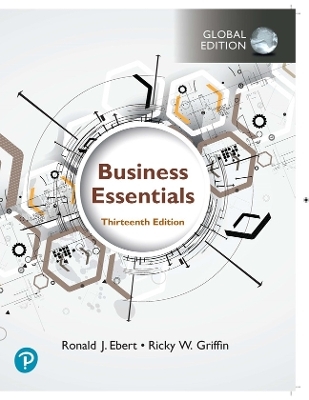
Introduction to Management Accounting 1-19 and Student CD package
Pearson
978-0-13-064971-3 (ISBN)
- Titel ist leider vergriffen;
keine Neuauflage - Artikel merken
Get refreshed with Horngren/Sundem/Stratton's Introduction to Management Accounting, Twelfth Edition. This best-selling text offers a relevant, real-world decision-making approach to management accounting. Students develop a solid understanding of costs and cost behavior and the use of cost information for planning and control decisions, not just inventory valuation.
An exceptionally strong pedagogy and supplements package and flexible structure provide instructors with great latitude in choosing various combinations of breadth and depth, theory and procedures, simplicity and complexity.
The Twelfth Edition now includes student-oriented real-world company examples such as Nantucket Nectars and McDonalds; new “Cognitive Exercises” and “Business First” boxes, new on-line courses and tutorial software package resources, and a new CD-ROM series, “Mastering Accounting.”
(NOTE: The alternate version of this text only contains chapters 1-15.)I. FOCUS ON DECISION MAKING.
1. Managerial Accounting & the Business Organization.
Chapter Opener: Cisco Systems. Accounting and Decision Making. Effects of Government Regulation. Management Accounting in Service and Nonprofit Organizations. Cost-Benefit and Behavioral Considerations. The Management Process and Accounting. Illustration of Budgets and Performance Reports. Planning and Control for Product Life Cycles and the Value Chain. Accounting's Position in the Organization. Career Opportunities in Management Accounting. Adaptation to Change. Just-in-Time Philosophy and Computer-Integrated Manufacturing. Importance of Ethical Conduct. Highlights to Remember. Accounting Vocabulary. Fundamental Assignment Material. Additional Assignment Material.
2. Introduction to Cost Behavior and Cost-Volume Relationships.
Chapter Opener: Boeing. Activities, Costs, and Cost Drivers. Comparison of Variable and Fixed Costs. Cost-Volume-Profit Analysis. Additional Uses of Cost-Volume Analysis. Nonprofit Application. Highlights to Remember. Appendix 2A: Sales-Mix Analysis. Appendix 2B: Impact of Income Taxes. Accounting Vocabulary. Fundamental Assignment Material. Additional Assignment Material.
3. Measurement of Cost Behavior.
Chapter Opener: America West. Cost Drivers and Cost Behavior. Management Influence on Cost Behavior. Cost Functions. Methods of Measuring Cost Functions. Highlights to Remember. Appendix 3: Use and Interpretation of Least-Squares Regression. Accounting Vocabulary. Fundamental Assignment Material. Additional Assignment Material.
4. Cost Management Systems and Activity-Based Costing.
Chapter Opener: AT&T. Cost Management Systems. Different Costs for Different Decisions. Activity-Based Costing. Illustration of Activity-Based Costing. Activity-Based Management. Highlights to Remember. Accounting Vocabulary. Fundamental Assignment Material. Additional Assignment Material.
5. Relevant Information and Decision Making: Marketing Decisions.
Chapter Opener: Grand Canyon Railway. The Concept of Relevance. The Special Sales Order. Deletion or Addition of Products, Services, or Departments. Optimal Use of Limited Resources. Pricing Decisions. General Influences on Pricing in Practice. Role of Costs in Pricing Decisions. Target Costing. Highlights to Remember. Accounting Vocabulary. Fundamental Assignment Material. Additional Assignment Material.
6. Relevant Information and Decision Making: Production Decisions.
Chapter Opener: Nantucket Nectars. Opportunity, Outlay, and Differential Costs. Make-or-Buy Decisions. Joint Product Costs. Irrelevance of Past Costs. Irrelevance of Future Costs That Will Not Differ. Beware of Unit Costs. Conflicts Between Decision Making and Performance Evaluation. How Income Statements Influence Decision Making. Highlights to Remember. Accounting Vocabulary. Fundamental Assignment Material. Additional Assignment Material.
II. ACCOUNTING FOR PLANNING AND CONTROL.
7. The Master Budget.
Chapter Opener: The Ritz-Canton. Budgets and the Organization. Preparing the Master Budget. Difficulties of Sales Forecasting. Getting Employees to Accept the Budget. Financial Planning Models. Highlights to Remember. Appendix 7: Use of Spreadsheets for Budgeting. Accounting Vocabulary. Fundamental Assignment Material. Additional Assignment Material.
8. Flexible Budgets and Variance Analysis.
Chapter Opener: McDonald's. Flexible Budgets: Bridge Between Static Budgets and Actual Results. Isolating the Causes of Variances. Flexible-Budget Variances in Detail. Overhead Variances. General Approach. Highlights to Remember. Accounting Vocabulary. Fundamental Assignment Material. Additional Assignment Material.
9. Management Control Systems and Responsibility Accounting.
Chapter Opener: Foundation Health Systems. Management Control Systems. Designing Management Control Systems. Controllability and Measurement of Financial Performance. Nonfinancial Measures of Performance. Management Control Systems in Service, Government, and Nonprofit Organizations. Future of Management Control Systems. Highlights to Remember. Accounting Vocabulary. Fundamental Assignment Material. Additional Assignment Material.
10. Management Control in Decentralized Organizations.
Chapter Opener: Nike. Centralization Versus Decentralization. Transfer Pricing. Performance Measures and Management Control. Measures of Profitability. ROI or Residual Income? A Closer Look at Invested Capital. Keys to Successful Management Control Systems. Highlights to Remember. Accounting Vocabulary. Fundamental Assignment Material. Additional Assignment Material.
III. CAPITAL BUDGETING.
11. Capital Budgeting.
Chapter Opener: Deer Valley Lodge. Capital Budgeting for Programs or Projects. Discounted-Cash-Flow Models. Sensitivity Analysis and Risk Assessment in DCF Models. The NPV Comparison of Two Projects. Income Taxes and Capital Budgeting. Confusion About Depreciation. Capital Budgeting and Inflation. Other Models for Analyzing Long-Range Decisions. Performance Evaluation. Highlights to Remember. Accounting Vocabulary. Fundamental Assignment Material. Additional Assignment Material.
IV. PRODUCT COSTING.
12. Cost Allocation.
Chapter Opener: Dell Computer Corporation. Cost Allocation in General. Allocation of Service Department Costs. Allocation of Costs to Final Cost Objects. Activity-Based-Costing (ABC) Approach. Allocation of Joint Costs and By-Product Costs. Highlights to Remember. Accounting Vocabulary. Fundamental Assignment Material. Additional Assignment Material.
13. Job-Costing Systems.
Chapter Opener: Dell Computer Corporation. Distinction Between Job Costing and Process Costing. Illustration of Job Costing. Accounting for Factory Overhead. Illustration of Overhead Application. Problems of Overhead Application. Activity-Based Costing/Management in a Job-Costing Environment. Product Costing in Service and Nonprofit Organizations. Highlights to Remember. Accounting Vocabulary. Fundamental Assignment Material. Additional Assignment Material.
14. Process-Costing Systems.
Chapter Opener: Nally and Gibson Georgetown, Inc. Process Costing Basics. Application of Process Costing. Physical Units and Equivalent Units (Steps 1 and 2). Calculation of Product Costs (Steps 3 to 5). Effects of Beginning Inventories. Weighted-Average Method. First-In, First-Out Method. Process Costing in a JIT System: Backflush Costing. Highlights to Remember. Appendix 14: Hybrid Systems-Operation Costing. Accounting Vocabulary. Fundamental Assignment Material. Additional Assignment Material.
15. Overhead Application: Variable and Absorption Costing.
Chapter Opener: L.A. Darling Company. Variable Versus Absorption Costing. Fixed Overhead and Absorption Costs of Product. Effect of Other Variances. Highlights to Remember. Appendix 15: Comparisons of Production-Volume Variance with Other Variances. Accounting Vocabulary. Fundamental Assignment Material. Additional Assignment Material.
V. BASIC FINANCIAL ACCOUNTING.
16. Basic Accounting: Concepts, Techniques, & Conventions.
Chapter Opener: Lands' End. The Need for Accounting. Financial Statements. Accrual Basis and Cash Basis. Adjustments to the Accounts. Adjustment Type I: Expiration of Unexpired Costs. Adjustment Type II: Recognition (Earning) of Unearned Revenues. Adjustment Type III: Accrual of Unrecorded Expenses. Adjustment Type IV: Accrual of Unrecorded Revenues. Dividends and Retained Income. Preparing Financial Statements. Sole Proprietorships and Partnerships. Generally Accepted Accounting Principles. Three Measurement Conventions. Highlights to Remember. Appendix 16A: Additional Accounting Concepts. Appendix 16B: Using Ledger Accounts. Accounting Vocabulary. Assignment Material. Fundamental Assignment Material. Additional Assignment Material.
17. Understanding Corporate Annual Reports: Basic Financial Statements.
Chapter Opener: Oracle Corporation. Classified Balance Sheet. Income Statement. Statement of Retained Earnings. Statement of Cash Flows. Interpretation of a Statement of Cash Flows: The Direct Method. Interpretation of a Statement of Cash Flows: The Indirect Method. Highlights to Remember. Appendix 17: Shareholder Reporting, Income Tax Reporting, and Deferred Taxes. Accounting Vocabulary. Fundamental Assignment Material. Additional Assignment Material.
18. More on Understanding Corporate Annual Reports.
Chapter Opener: General Motors. Part One: Intercorporate Investments Including Consolidations. Market and Equity Methods. Consolidated Financial Statements. Highlights to Remember: Part One. Accounting Vocabulary. Part Two: Analysis of Financial Statements. Uses of Ratios. Efficient Markets and Investor Decisions. Highlights to Remember: Part Two. Accounting Vocabulary. Fundamental Assignment Material. Additional Assignment Material.
19. Difficulties in Measuring Net Income.
Chapter Opener: Home Depot. Part One: Principal Inventory Methods. Four Major Inventory Methods. Lower-of-Cost-or-Market (LCM) Method. Highlights to Remember: Part One. Accounting Vocabulary: Part One. Part Two: Changing Prices and Income Measurement. Income or Capital. Measurement Alternatives Under Inflation. Highlights to Remember: Part Two. Accounting Vocabulary: Part Two. Fundamental Assignment Material. Additional Assignment Material.
Appendix A.
Appendix B.
Glossary.
Index.
Photo Credits.
| Erscheint lt. Verlag | 12.11.2003 |
|---|---|
| Sprache | englisch |
| Gewicht | 1000 g |
| Themenwelt | Wirtschaft ► Betriebswirtschaft / Management |
| ISBN-10 | 0-13-064971-6 / 0130649716 |
| ISBN-13 | 978-0-13-064971-3 / 9780130649713 |
| Zustand | Neuware |
| Haben Sie eine Frage zum Produkt? |
aus dem Bereich


